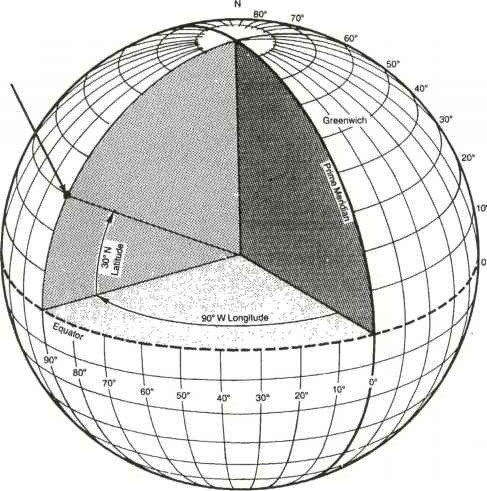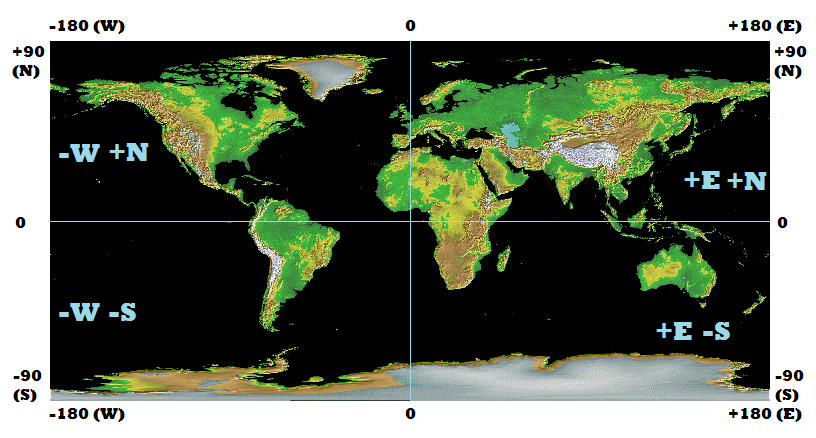The compass points north.
Being more specific the compass points to align itself the strongest magnetic field, which may or may not be grid north, usually not.
The north pole where all the lines of the map grid connect, sadly is not the magnet north pole, the same is true for the south pole.
The south pole is not even under Antarctica, it is not even covered in permanent ice, its just off the coast of Antarctica in the southern ocean.
With the right ship you could sail to the magnetic south pole.
So because of this you will need to add a correction factor (magnetic declination) based on exactly where you are on the earth (and years since map printed).
The world magnetic declination chart 2001
So what does this mean?
This will show you how much you compass be away from grid north when pointing to magnetic north and whether magnet north will be to the east or west of grid north.
Examples
in the area of former French Indochina Vietnam Cambodia, Laos and Thailand there is very little magnetic variation, less than 1 degree, so in that area grid north and magnetic north are almost identical.

magnetic declination in Former french Indochina, Laos, Cambodia ,Burma, Vietnam. Almost less than 1 degree, magnetic and grid north almost the same
For the USA and Canada the situation is much more complex
In the east the declination is to the west and in the west the declination is to the east.

Magnetic declination for the USA and Canada
The declination becomes extreme in the Alaska and western Canada areas.

Magnetic declination Alaska and western Canada
Here the declination becomes quite significant, in Banks island the declination is around 40 degrees, being that the difference between East and North-East is 45 degrees, you would not want to get this wrong.
Australia and New Zealand

Magnetic declination Australia and New Zealand.
The declination problem is as extreme as the case for North America, the real issue especially for Australia is the magnetic anomalies.
You might recall that Australia is (in many places) simply made from iron ore, and iron is magnetic.
Interestingly in Australia declination changes most significantly as you move east and west, in New Zealand declination changes most when you move north and south. further more both countries have a major city close to the line of no yearly declination variation ( Brisbane and Auckland)
Changes in magnetic declination yearly
Magnetic declination (and the location of the magnetic poles) changes with time.
The measurements of change are in the above charts as light blue lines and are in the units of minutes per year ( 1 minute being 1/60 of a degree).
Here is an animation of the slow changes in declination over a 400 year period from the USGS.

Earth Magnetic Field Declination from 1590 to 1990
Please note the most recent data on the animation is from 1990 as i write this its 22 years out of date so the charts from 2001 are more accurate.
Find your declination based on your IP address
http://magnetic-declination.com/
Manual calculation of declination changes
To do calculations on declination fist we must understand that the traditional navigation numerical system is
in base 60. Just like your wrist watch or clock, there are 60 minutes in an hour there are 60 minutes in an
degree. Change to declination due to shifts in the earths magnetic field are measured in minutes per year and just like declination itself, it is dependent on the position you are on the planet.
If you’re wondering where this numerical system came from, it came from Sumer, the first known civilization. While it seems like an awkward system at first, it is worth understanding, as it is completely embedded in geography, cartography navigation, astronomy and the measurement of time. Long after Sumerian was a dead language, scholars were studying Sumerian cuneiform to understand Sumerian knowledge of astronomy and cartography; all described in base 60: degrees, minutes and seconds.
Once a workable standard gets established, it gains considerable momentum.
http://implementimprovement.com/?p=1689
For simplicity of mathematics we will arbitrarily assign east to positive declination and west to negative declination. As north is considered to be 0 or 360 degrees on a compass this will make sence, 15 degrees east is +15 degrees 20 degrees west is 340 degrees (360 -20). Just like on a clock at midday it is 12 and the next hour is 1 and the previous hour is 11.
Math with degrees minutes and seconds
1 degree = 60 minutes = 3600 seconds
with notation
1° = 60′ = 3600″
Example 1
Melbourne, Australia
In 2001 declination was 11.5 E; which is 11 degrees 30 minutes E.
Change in declination was 0.75 minutes per year E; which is 0 minutes 45 seconds.
Time passed since map drawn was 11 years
Total declination change 11 x 0’45″E
This is the same as saying how many minutes have passes in 11 45 second time periods.
11 x 45 seconds = 495 seconds
In minutes and seconds?
495 / 60 = 8.25 = 8 minutes 15 seconds ( 0.25 of a minute is a quarter of a minute, which is 15 seconds)
8′ 15″ E
Convert all E to + and all W to –
+11° 30′ + 0° 8′ 15″
+11° 38′ 15″
Convert + to E and – to W
11° 38′ 15″ E
Example 2
Banks Island, Canada
I selected a location where the declination line 39°E crossed the declination change 45′ W as a more extreme example
Time passed since map drawn was 11 years.
Total declination change 11 x 45′ W = 495′
How many degrees and minutes is this?
495/60 = degrees of change = 8.25 which is 8 15′ W
Interestingly the math was identical as before but the magnitude is 60 times larger.
Converting E to + and W to –
39° 0′ – 8° 15′ = 30° 45′

Declination calculation in Degrees Minutes Seconds example
A hand written calculation of the example. please note the carry of the 6, which is really carry the 60 minutes
39° 00′ = 38° 60′
Because 1 degree = 60 minutes
+30° 45′
Convert + to E and – to W
30° 45′ E
So now that I have explained all of this and not even shown a picture of a compass you may be wondering about my logic.
Navigation by compass is not a simple affair, well not as simple as it appears once declination and declination change is taken into account.
The real importance of understanding declination becomes apparent once you are doing one or more of the following:
Traveling long distance.
Traveling on featureless terrain, desert, tundra, steeps, prairie, ocean.
Attempting to triangulate your position from landmarks.
Making decisions based on precise measurement of where north or south is, such as a sundial orientation or solar panel placement.
Using a very old map.
In a location with large annual declination change ( Canada, eh ).
Using a sextant.
Learn the parameters of your tools.
There is nothing worse than having too much faith in a tool you really don’t understand the subtleties of.
I will add that in trying to explain all of this, which was 24 hours of research and writing, I learned a lot.
I hope you have learned a lot too. You’ll never think about North the same way again.
Even so unless I’m on the ocean, I say the map is far more important than the compass.











You must be logged in to post a comment.